Whether you’re looking to brighten up your current community tank or create a brand new display tank to marvel at, you’ve got a lot of options available to you.
To help you narrow down the most colorful and coolest freshwater fish for you, I’ve created this list of my favorite picks to help you.
In this guide, you’ll discover a wide range of colorful freshwater fish from beginner level to expert to help you create a beautiful looking tank you won’t be able to take your eyes off.
1. Discus (Symphysodon sp.)
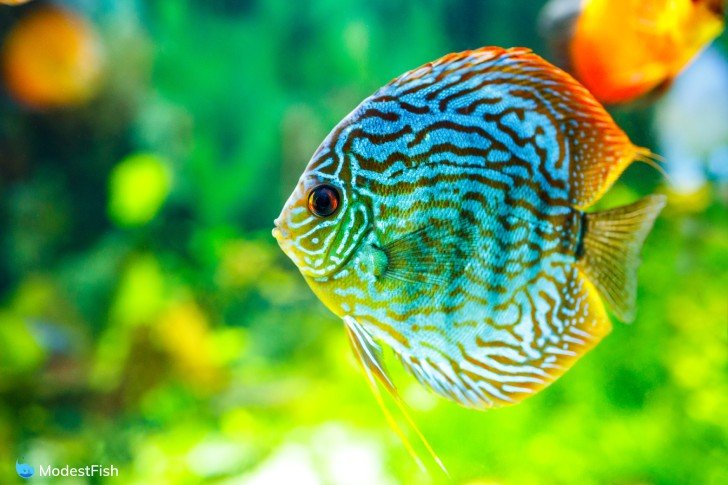
- Common Names: Discus
- Scientific Name: Symphysodon sp.
- Family: Cichlidae
- Lifespan: 10 years
- Size: 6.5-8 inches (16.5-20.3 cm)
- Tank size: 30 gallon (113 liters)
- Temperature: 82°-86°F (27.7°-30°C)
- pH: 6-7
- Hardness: 2-5 dGH (33.3-83.4 ppm)
- Compatibility: Keep with peaceful community fish
- Care level: Expert
Named after their disc shaped bodies, discus are available in an array of cool patterns, colors, stripes, spots, or striatations.
This fish has become famous for its bright colorful patterns derived from selective breeding. Common varieties are often pretty shades and intensities of green, red, brown and blue.
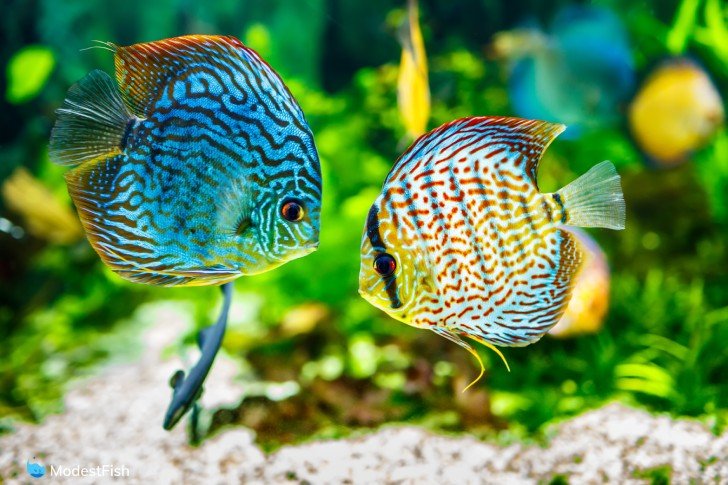
When it comes to choosing a colorful freshwater fish for your aquarium though, discus are not one I would recommend for a beginner.
If you do choose dicus, you’ll need a 55 gallon tank (minimum), filled with lots of live plants, decorations, and open swimming areas. Since this species is a shoaling fish, you should keep a minimum of 3-5 together.
2. German Blue Ram (Mikrogeophagus ramirezi)

- Common Names: German Blue Ram, Ram Cichlid, German Blue
- Scientific Name: Mikrogeophagus ramirezi
- Family: Cichlidae
- Lifespan: 3 years
- Size: 2-3 inches (5-7.6 cm)
- Tank size: 30 gallon (113 liters)
- Temperature: 82°-86°F (27.7°-30°C)
- pH: 6-7
- Hardness: 2-5 dGH (33.3-83.4 ppm)
- Compatibility: Keep with peaceful community fish
- Care level: Expert
German blue rams (also known as the Ram Cichlid) are a popular colorful cichlid, with electric yellow oval bodies and brilliant blue spots covering with abdomen, tail, fins, and distinctive black stripes running through their bright red eyes.
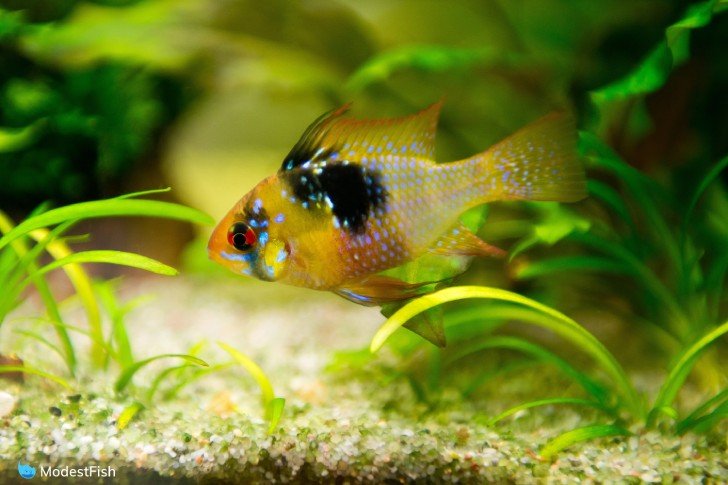
Males have a more pointed fin whereas females tend to be smaller in size and have a pinkish-orange belly.
When setting up your tank and habitat for a german blue ram, you’ll need a minimum size of 20 gallons for a pair, with lots of plants and hiding spots. Rams like to live and claim territory in the mid to bottom levels of the tank. Although these are naturally a peaceful fish, they can sometimes become aggressive with other rams over territory.
You would need to be a reasonably well experienced aquarist to keep these cool fish as they are particularly sensitive to poor water parameters (especially nitrate levels). They do require regular weekly water changes.
3. Betta (Betta splendens)
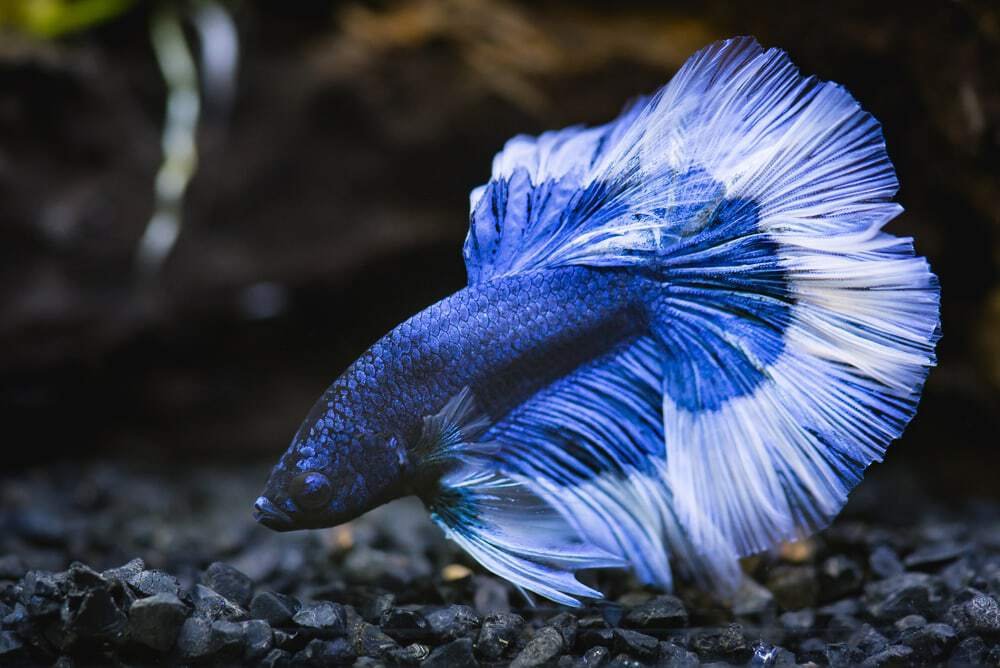
- Common Names: Betta Fish, Siamese Fighting Fish
- Scientific Name: Betta splendens
- Family: Osphronemidae
- Lifespan: 2-5 years
- Tank size: 5 gallons (18.9 liters)
- Temperature: 76°-82°F (24.4°-27.7°)
- pH: 6.5-7
- Hardness: 3-4 dGH (50-66.7 ppm)
- Compatibility: Best kept alone
- Care level: Beginner
Betta fish are some of the prettiest freshwater fish available in the aquarium trade. Arguably the most colorful tropical fish.
Growing up to approximately 2 inches, bettas are available in a variety of color and pattern types: solid, marble, butterfly, koi, dalmatian, and more. You’ve then got the tail variations: veil, crown, dumbo, halfmoon, double, just to name a few.
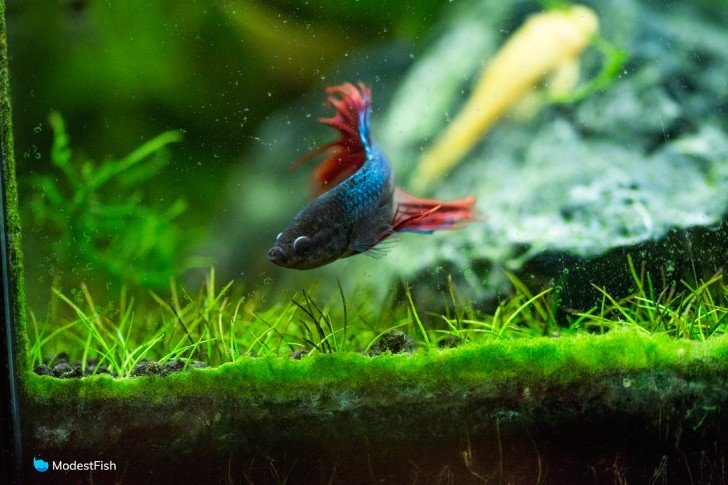
An excellent starter fish, you would need a planted 5 gallon set up (minimum). Males should be housed alone due to their aggressive nature. Females can be kept in sororities, but this would be for advanced aquarists.
4. Cardinal Tetra (Paracheirodon axelrodi)
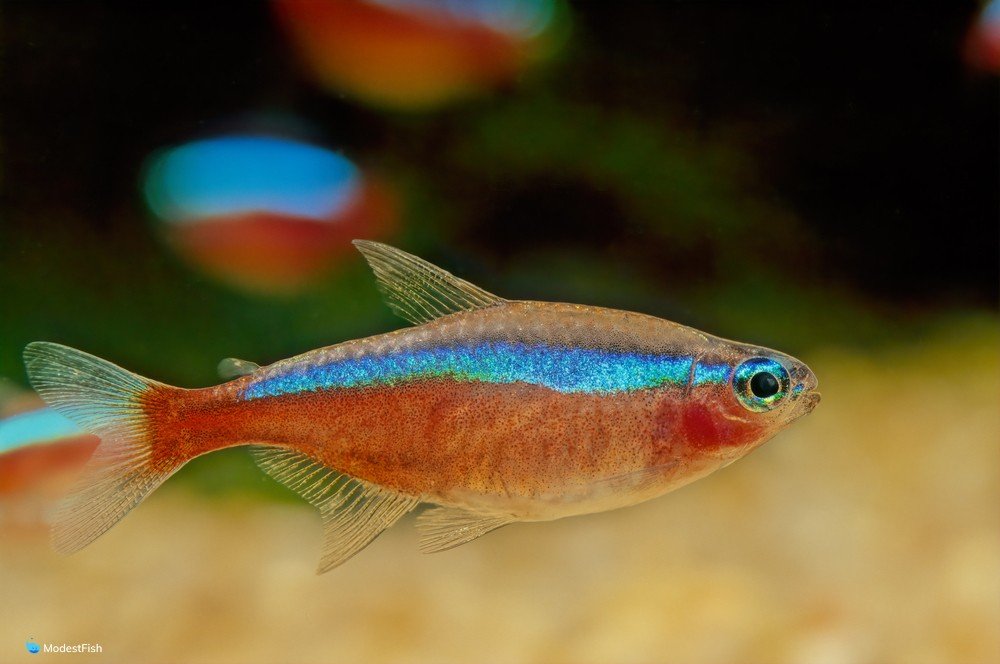
- Common Names: Cardinal tetra, large neon tetra, red neon, roter neon
- Scientific Name: Paracheirodon Axelrodi
- Family: Characidae
- Lifespan: 5 years
- Size: 2 inches (5 cm)
- Tank size: 15 gallons (38 liters)
- Temperature: 73°-79°F (22.7°-26.1°C)
- pH: 5.5-6.5
- Hardness: 1-3 dGH (16.7-50 ppm)
- Compatibility: keep with peaceful community fish
- Care level: Beginner
This stunning nano fish comes from the family of Characidae of order Characiformes. The cardinal tetra’s torpedo body has beautiful ventral parts with neon blue and red stripes running the length of its body.
A large school of cardinal tetras in a freshwater, planted aquarium makes for a truly show-stopping spectacle.
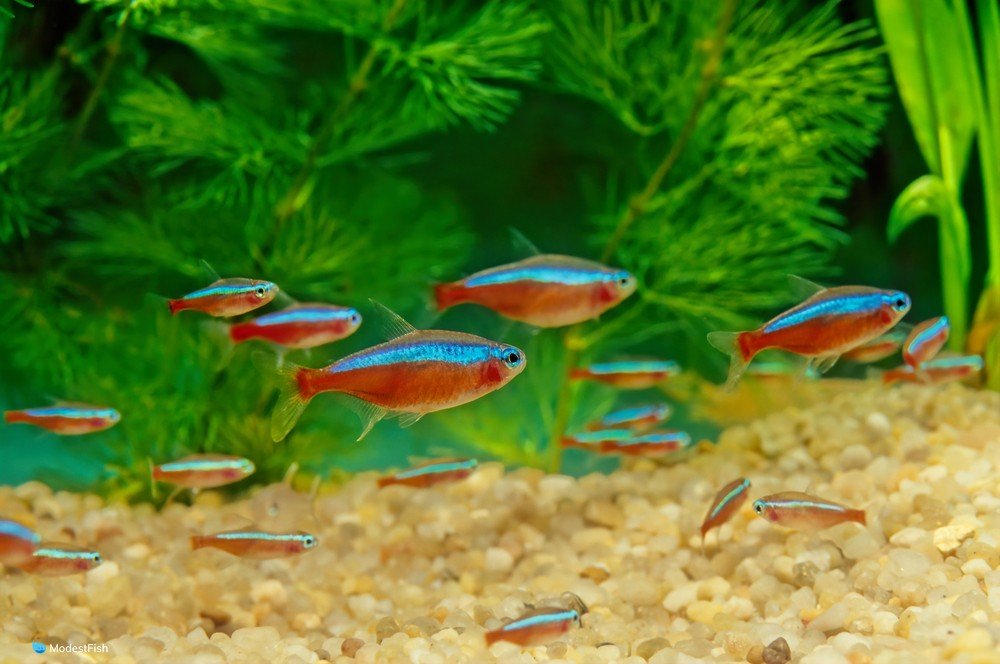
This colorful schooling fish will do best in a school of at least six in a 15 gallon tank, but a larger shoal in a bigger tank will always be better.
5. Neon Tetra (Paracheirodon innesi)
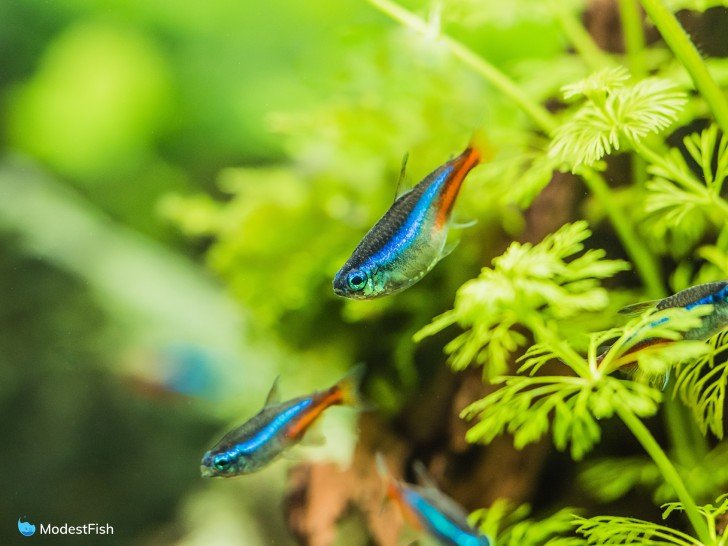
- Common Names: Neon Tetra, Neon Fish
- Scientific Name: Paracheirodon innesi
- Family: Characidae
- Lifespan: 10 years
- Size: 1.2 inches (3 cm)
- Tank size: 10 gallon (38 liters)
- Temperature: 72°-76°F (22.2°- 24.4°C)
- pH: 6-7
- Hardness: <10 dGH (<166.7 ppm)
- Compatibility: keep with peaceful community fish
- Care level: Beginner
Similar to the cardinal tetra, the neon tetra comes from the same family. However, this pretty freshwater fish’s iridescent blue stripe runs from nose to adipose fin and the red from tail to dorsal fin.
Again, a large school of neon tetras can make for a truly mesmerizing viewing experience. And are always a great choice for anyone who wants a colorful community tank.
Slightly smaller than the cardinal, neons should be kept in a 10 gallon planted tank (minimum) in a school of at least 6. Again, a larger tank with a bigger shoal will always make for a more colorful show.
6. Dwarf Gourami (Trichogaster lalius)
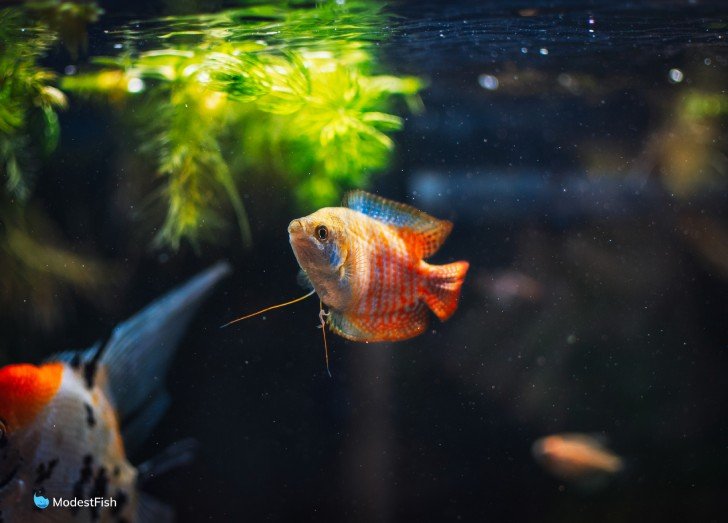
- Common Names: Dwarf Gourami, Flame Gourami, Powder Blue Gourami, Red Gourami, Sunset Gourami, Honey Gourami
- Scientific Name: Trichogaster lalius
- Family: Osphronemidae
- Lifespan: 3-4 years (38 liters)
- Tank size: 10 gallon (38 liters)
- Temperature: 77°-82°F (25°-27.8°C)
- pH: 6-9
- Hardness: 5-20 dGH (83.4-333.4 ppm)
- Compatibility: keep with slow-moving, peaceful community fish
- Care level: Beginner
Dwarf gouramis are one of my personal favorite colorful freshwater fish.
A peaceful fish, it has a oval-shaped body with large anal and dorsal fins. And the color varieties and combinations available are absolutely stunning.
Dwarf gouramis can be neon blue, metallic blue, powdered blue, flame red, honey colored, with spots, stripes and solids. They really are a beautiful fish to add to your community tank.
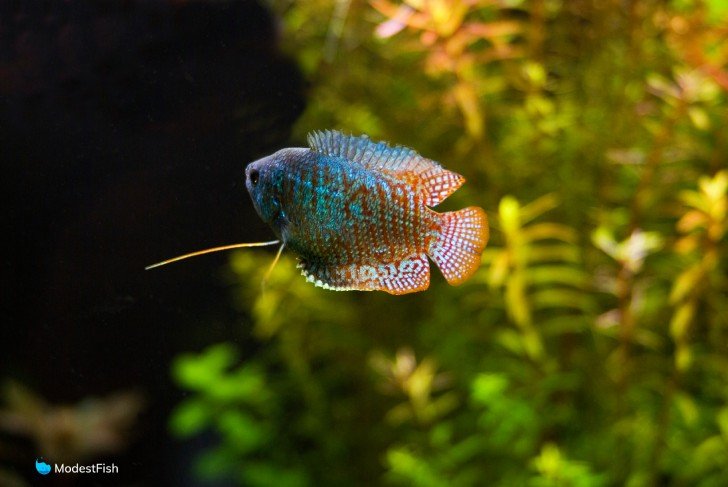
What makes them stand out from others is their pair of modified pelvic fins. These are used as “feelers” to investigate and help them navigate their surroundings.
If you want to keep a group of dwarf gouramis in your tank, you’d need at least 10 gallons. Avoid housing with aggressive fish. Dwarf gouramis tend to stil to the upper levels of the tank so are best housed with mid and bottom dwellers.
Although peaceful in nature, males can become aggressive to one another. So if you’re keeping a group of them, you should have one male per 4-5 females.
7. Jack Dempsey Cichlid (Rocio octofasciata)
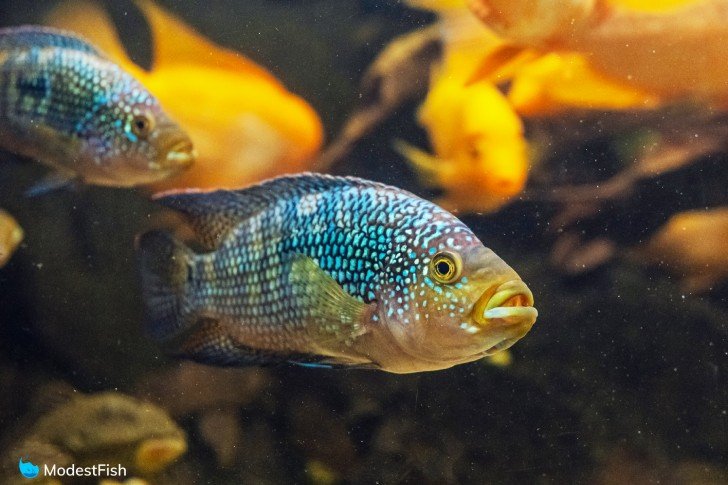
- Common Names: Jack Dempsey
- Scientific Name: Rocio octofasciata
- Family: Cichlidae
- Lifespan: 10 years
- Size: 10 inches (25.4 cm)
- Tank size: 55 gallon (210 liters)
- Temperature: 78°-86° F (25.6°-30°C)
- pH: 6.5-8
- Hardness: 5-12 dGH (83.4-200 ppm)
- Compatibility: keep with other large fish like severums
- Care level: Intermediate
Their size, color, and personality have made the Jack Dempsey one of the most sought after colorful freshwater fish in the hobby.
Its oval-shaped fish has large dorsal and anal fins with a larfe rounded tail. Their base color ranges from a dusky, rosy pink all the way to a dark almost black color.
Covered in metallic, iridescent greeny-blue spangles, these spots reflect light and flash brightly as they swim.
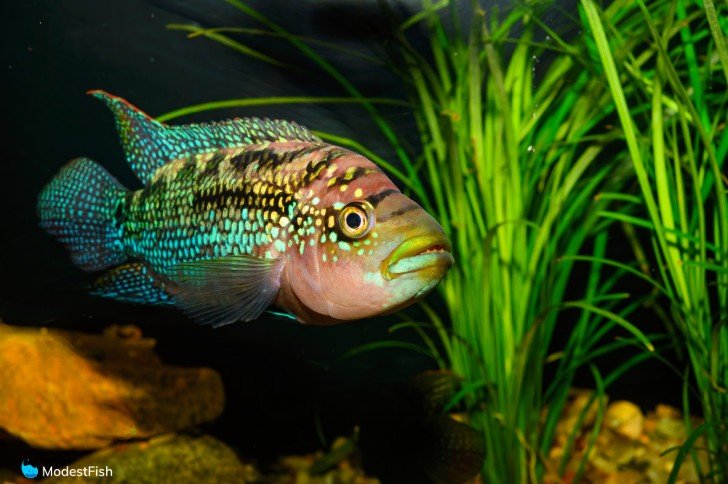
And like a fine wine, Jack Dempsey fish get better with age. As their iridescent spangles become more and more pronounced with age.
Its size, color, aggressive nature, and strong facial features make the Jack Dempsey top of the list when it comes to cool freshwater fish.
8. Boesemani Rainbow (Melanotaenia boesemani)
- Common Names: Boesemani Rainbow
- Scientific Name: Melanotaenia boesemani
- Family: Melanotaeniidae
- Lifespan: 5-8 years
- Size: 3-4.5 inches (7.6-11.4 cm)
- Tank size: 40 gallon (150 liters)
- Temperature: 81°-86°F (27.2°-30°C)
- pH: 7-8
- Hardness: 10-20 dGH (166.7-333.4 ppm)
- Compatibility: keep with peaceful community fish
- Care level: Beginner
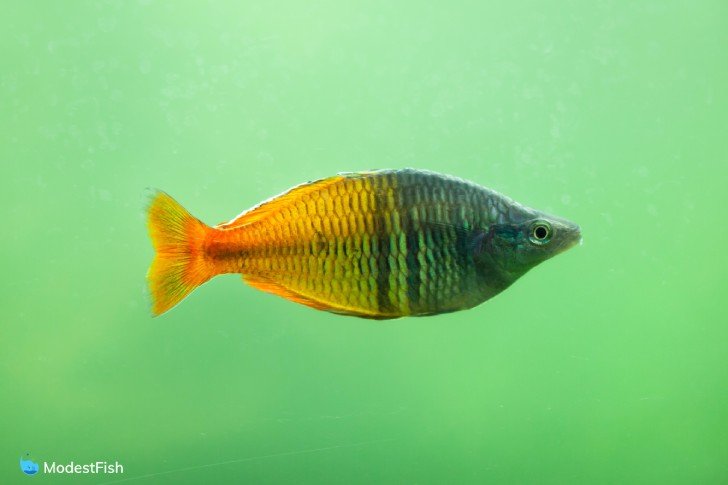
The Boesemani Rainbowfish is a pretty fish that gets a lot of attention in the aquarium industry.
A long-bodied fish, the color pattern of specifically the M. boesemani is what sets it apart from other types of rainbowfish. The front half being a powdered blueish-gray, and the rear half a bright orangy-yellow.
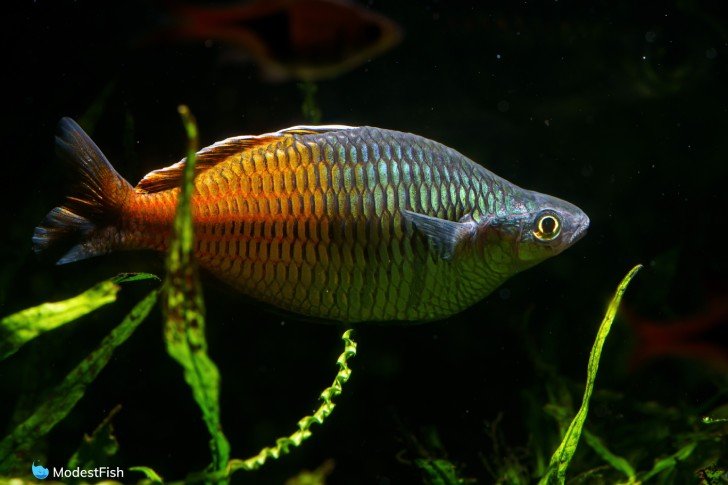
A peaceful community fish, when kept with other species like tetras, discus, guppies, or shrimp for example, you can create a beautiful tropical aquarium full of color and life.
9. Paradise Fish (Macropodus opercularis)
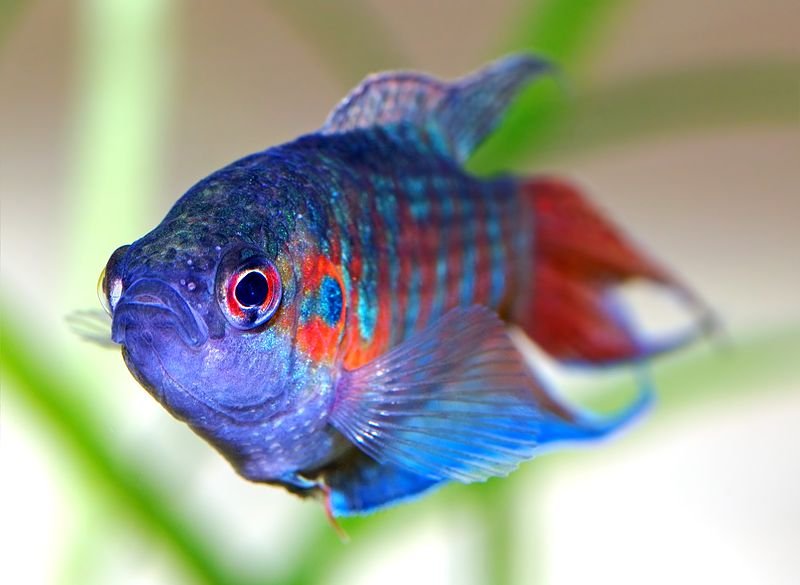
- Common Names: Paradise fish, Paradise-fish, Paradisefish, or Paradise gourami
- Scientific Name: Macropodus opercularis
- Family: Osphronemidae
- Lifespan: 6-8 years
- Size: 2.4 inches (6 cm)
- Tank size: 20 gallon (75 liters)
- Temperature: 70°-82°F (21.2°-27.8°C)
- pH: 6-8
- Hardness: 5-30 dGH (83.4-500 ppm)
- Compatibility: should not be kept with other gouramis or bettas. Fancy guppies may also be a problem. Male paradise fish may see these as another paradise fish. Otherwise, they can be kept with peaceful community fish.
- Care level: Beginner
Paradise fish are as colorful and cool looking as they are aggressive. With their vivid blue and red striped bodied, large dorsal fins, and forked tail, Paradise fish are an eye-catching choice of freshwater fish.
They’re combative fish, displaying aggressive behaviors towards each other, as well as attacking and killing smaller fish. A unique feature of the Paradise fish is, during a fight, they’ll change color, displaying dark blue lateral lines along the side of its body. As well as, extending its fins and spreading out its operculum.
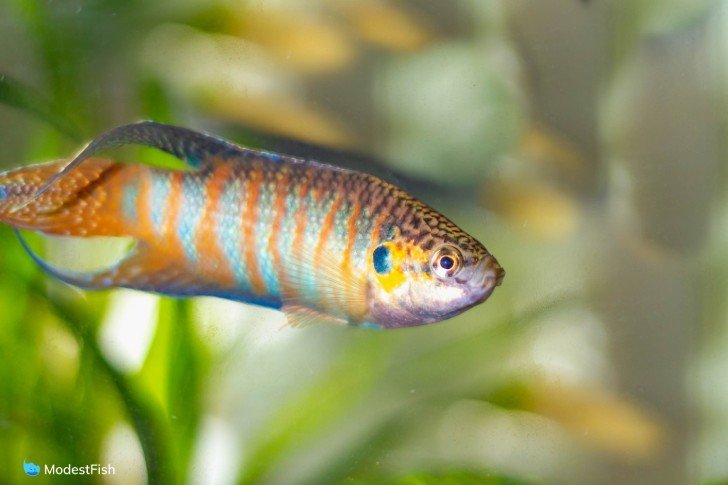
The safest way to keep paradise fish would be a species only tank with lots of plants. You’d want to keep one male per 4-5 females. It is possible to keep in a peaceful community, however, you must ensure they are the dominant species in the tank.
When housed with other aggressive fish, they will compete for control and will lead to regular fights.
10. Endlers (Poecilia wingei)
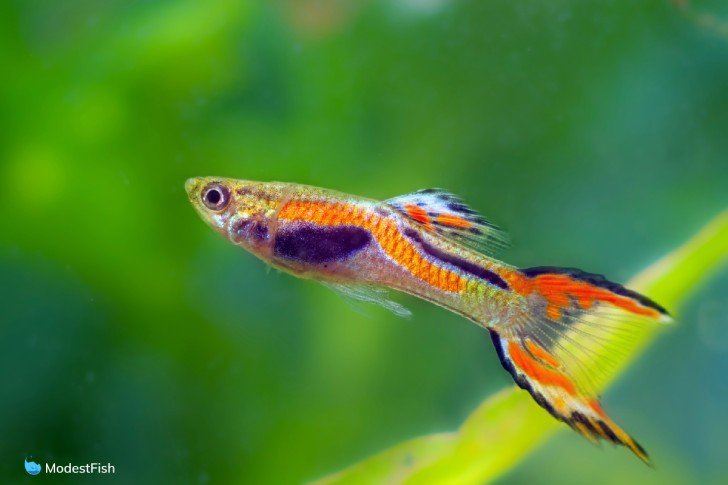
- Common Names: Endlers, Endler’s livebearer, Endler’s guppy
- Scientific Name: Poecilia wingei
- Family: Poeciliidae
- Lifespan: 2-3 years
- Size: 1-1.8 inches (2.5-4.5 cm)
- Tank size: 2 gallon (7.5 liters)
- Temperature: 70°-84°F (21.1°-28.9°C)
- pH: 7-8
- Hardness: 10-20 dGH (166.7-333.4 ppm)
- Compatibility: keep with peaceful community fish
- Care level: Beginner
Endlers (males) are a colorful typical fish with intense color markings. Including, black, orange, metallic green, yellows, blue and more. The color combinations are almost limitless at this point.
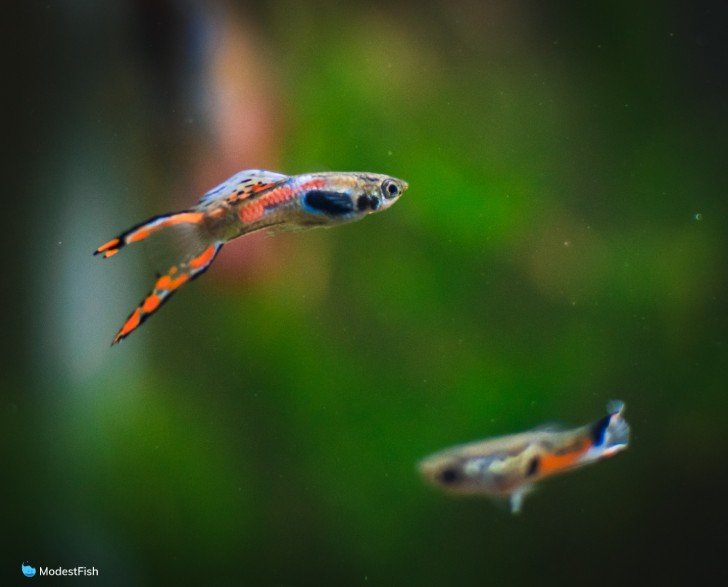
Their willingness to breed has made them a favorite to hybridize and selectively breed to create an array of pretty pattern and color combinations.
Readily available in all fish stores, endlers should be kept in a ratio of one male to 3-5 females to help control breeding. They are peaceful fish who do very well in planted community tanks and help bring a large splash of color and lots of fun activity.
11. Bluefin Notho (Nothobranchius rachovii)
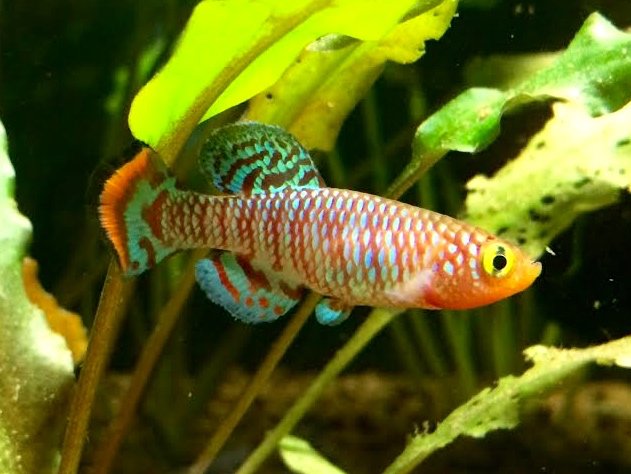
- Common Names: Bluefin Notho, Rachovii Killifish
- Scientific Name: Nothobranchius Rachovii
- Family: Nothobranchiidae
- Lifespan: 1 year
- Size: 2.4 inches (6 cm)
- Tank size: 10 gallon (38 liters)
- Temperature: 70°-75°F (21.1°-23.9°C)
- pH: 6-7
- Hardness: 2-5 dGH (33.3-83.4 ppm)
- Compatibility: keep with small, peaceful community fish
- Care level: Intermediate
Bluefin Notho are a vibrant, energetic freshwater killifish with red bodies covered in shiny metallic turquoise speckles.
This bottom to mid dwelling fish can be kept with other peaceful community fish, as long as they are similarly sized. Bluefin notho can be aggressive towards one another, so they are best kept in a ratio of one male per 3-5 females.
You will need at least a 10 gallon, heavily-planted tank with lots of hiding places and peat moss.
12. Flowerhorn Cichlid (man-made hybrid)
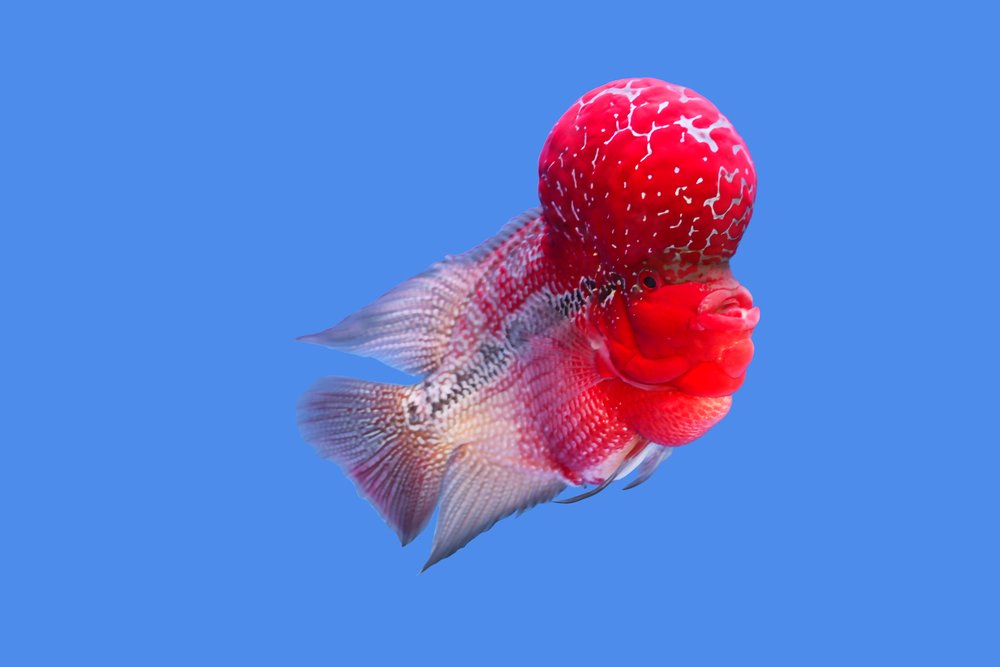
- Common Names: Flowerhorn, Flowerhorn cichlid, Kamfa, King Kamfa, Golden Monkey, Thai Silk, Red Dragon, Kamalau, Golden Base, Red Texas
- Family: Cichlidae
- Lifespan: 8-12 years
- Size: 10-12 inches (25.4-30 cm)
- Tank size: 75 gallon (284 liters)
- Temperature: 82°-85°F (27.8°-29.4°C)
- pH: 6-8.5
- Hardness: 6-20 dGH (100-333.4 ppm)
- Compatibility: cannot be kept with other fish. Pair is possible.
- Care level: Intermediate
Flowerhorns are one of the most interesting and coolest looking fish in the aquarium hobby. Commonly, flowerhorns have bright red/orange heads fading into white/golden bodies with dark spots along their lateral line.
Most varieties have long trailing rays at the ends of their dorsal and anal fins. Different color variants often come with different tail shapes. There are too many varieties to cover.
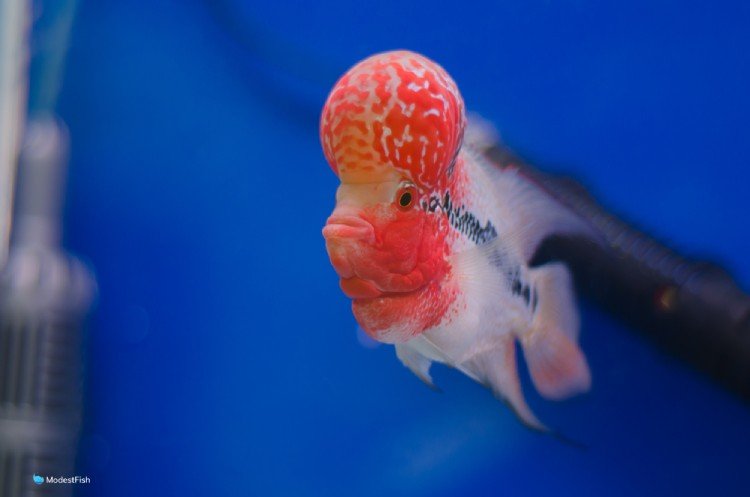
Their large, thick bodies, pronounced lips, and show-stopping nuchal lump makes them the focal point of any aquarium.
Very aggressive, flowerhorn cichlids should be housed alone in a 75 gallon tank. It is possible to house a pair (150 gallon tank) if they have been together since juveniles and grown up together.
13. Cherry Barb (Puntius titteya)
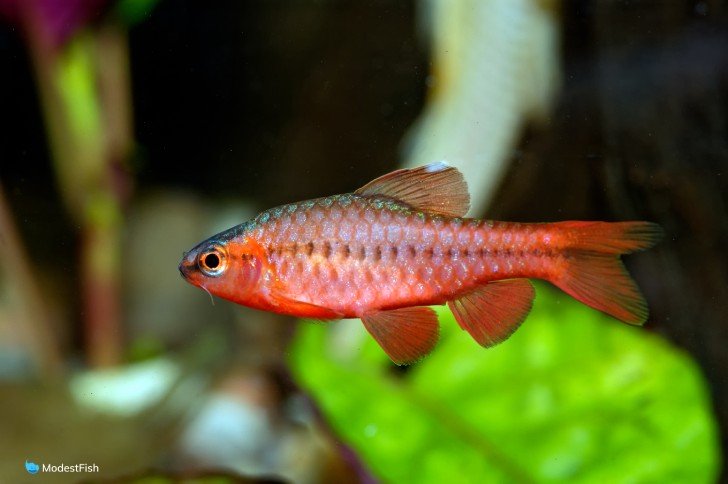
- Common Names: Cherry Barb
- Scientific Name: Puntius titteya
- Family: Cyprinidae
- Lifespan: 5-7 years
- Size: 2 inches (5 cm)
- Tank size: 20 gallon (75 liters)
- Temperature: 75°-80°F (23.9°-26.7°C)
- pH: 6-8
- Hardness: 3-20 dGH (50-333.4 ppm)
- Compatibility: keep with other peaceful community fish
- Care level: Beginner
Cherry Barbs get their name from their vivid red coloring covering their whole body. A peaceful schooling fish, when housed with others like neon tetra and rasboras, it can make for a picturesque community tank.
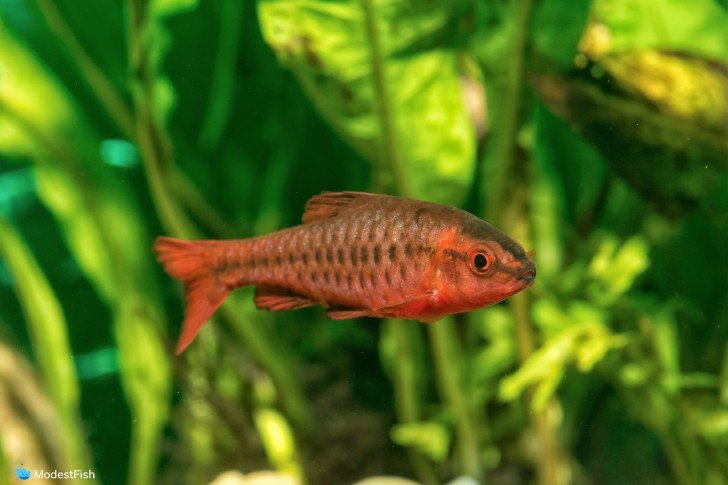
Males can get slightly aggressive when wanting to breed, so they are best kept in a ratio of one male to two females. The larger the school, the more active and playful they’ll be.
14. Electric Blue Hap (Sciaenochromis fryeri)
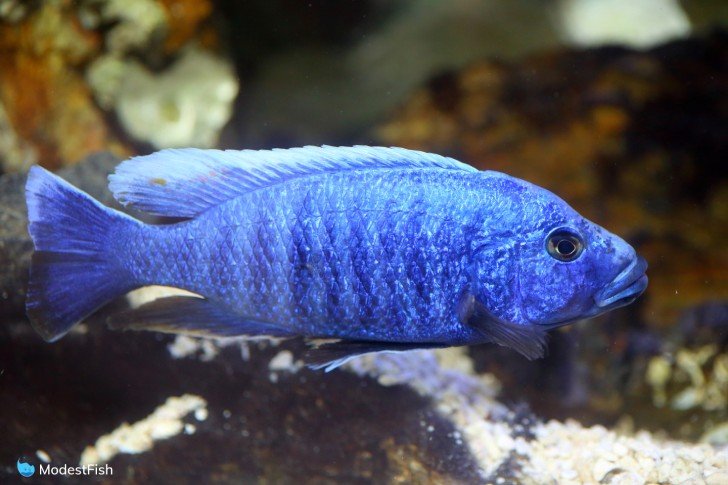
- Common Names: Electric Blue Hap
- Scientific Name: Sciaenochromis fryeri
- Family: Cichlidae
- Lifespan: 7-10 years
- Size: 6-7.9 inches (15.2-20 cm)
- Tank size: 55 gallon (210 liters)
- Temperature: 71°-80°F (21.7°-26.7°C)
- pH: 7-8.5
- Hardness: 18-25 dGH (300-417 ppm)
- Compatibility: keep with other Lake Malawi cichlids, as long as they do not look similar
- Care level: Intermediate
Electric blue haps have been one of the most popular African Cichlids in the aquarium community due to its coloration.
It’s long, slender-body can grow up to 7.9 inches in length and depicts intense eclectic blue coloring and dark blue vertical bars. These are active, territorial fish that’ll fight until the death if given the opportunity.
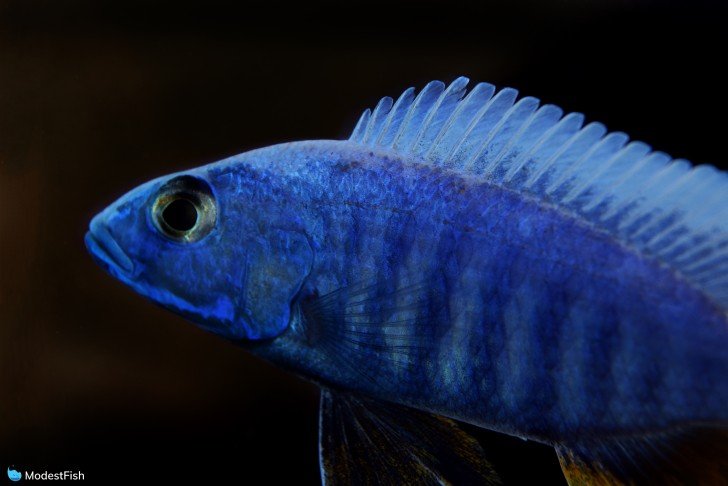
That’s why one male per tank is recommended. You can get away with more if your tank is extremely large, heavily planted, with sandy substrate and rock piles.
15. Electric Yellow Lab (Labidochromis caeruleus)
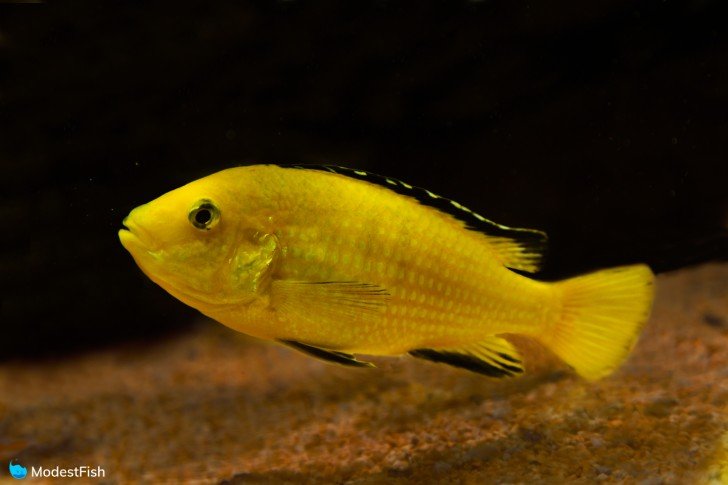
- Common Names: Electric yellow lab, lemon yellow lab, blue streak hap, electric yellow, yellow prince
- Scientific Name: Labidochromis caeruleus
- Family: Cichlidae
- Lifespan: 10-15 years
- Size: 4-5 inches (10-12.7 cm)
- Tank size: 55 gallon (210 liters)
- Temperature: 71°-80°F (21.7°-26.7°C)
- pH: 7-8.5
- Hardness: 18-25 dGH (300-417 ppm)
- Compatibility: other African cichlids from Lake Malawi
- Care level: Intermediate
Electric yellow labs are another popular African Cichlid amongst aquariums for their bold, vibrant yellow bodies with a black stripe along its dorsal fin.
Although peaceful in comparison to some other African Cichlids, electric yellow labs are notorious fin nippers and shouldn’t be kept in a freshwater community tank. This fish should be kept in an African Cichlid community tank with other Malawi species.
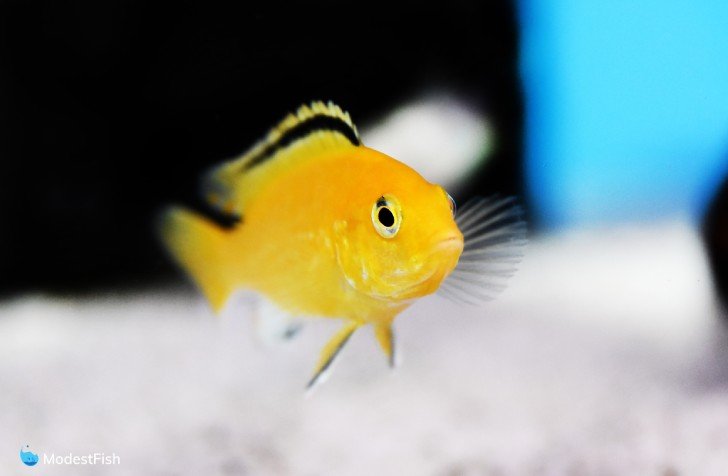
You will need a minimum 55 gallon tank with sandy substrate and rockle piles with caves. It’s best to keep one male with several females as males can become aggressive to one another.
16. Harlequin Rasboras (Trigonostigma heteromorpha)
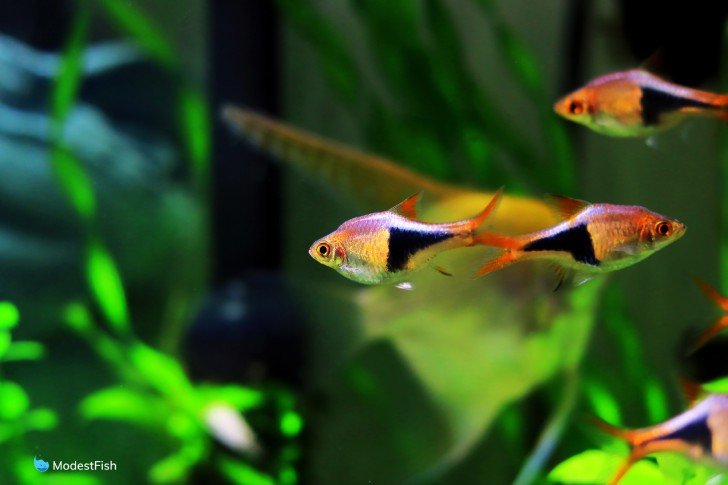
- Common Names: Harlequin Rasboras, Red Rasbora
- Scientific Name: Trigonostigma heteromorpha
- Family: Cyprinidae
- Lifespan: 5 years
- Size: 2 inches (5 cm)
- Tank size: 20 gallon (75 liters)
- Temperature: 72°-77°F (22.2°-25°C)
- pH: 6-7
- Hardness: 5-10 dGH (83.4-167 ppm)
- Compatibility: keep with other peaceful community fish
- Care level: Beginner
Harlequin Rasboras are a stunning little freshwater fish with a vibrant, ruby lozenge-shaped body with a black wedge running from their dorsal fin to their tail.
Excellent in a peaceful community tank, due to their active schooling behaviors, Harlequin Rasboras will really create some colorful spectacles as they race across your tank.
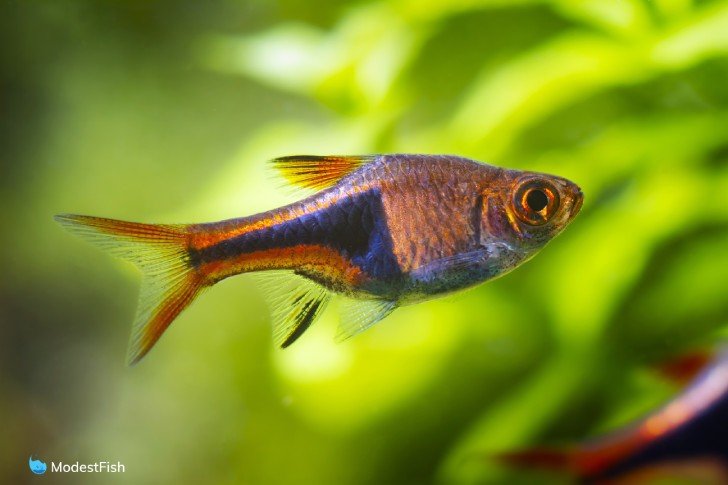
If you would like to add some colorful harlequin rasboras to your tank, make sure it’s heavily planted with lots of open swimming areas to get the most pleasurable view experience.
17. Salvini Cichlid (Cichlasoma salvini)
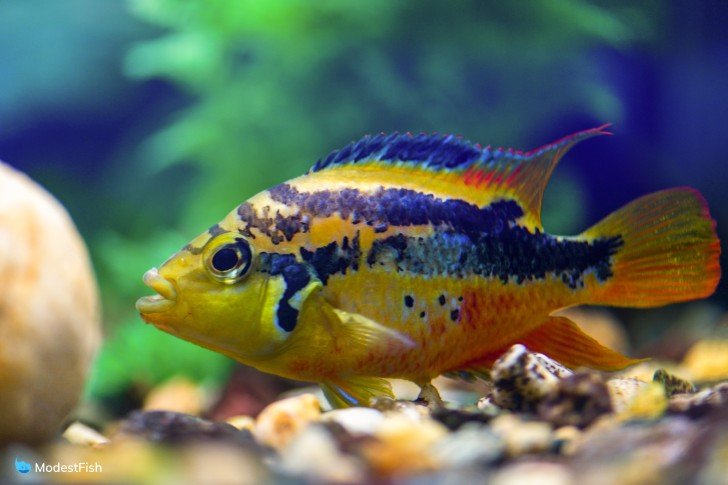
- Common Names: Salvini Cichlid, Yellow-belly Cichlid, Tricolored Cichlid
- Scientific Name: Cichlasoma salvini
- Family: Cichlidae
- Lifespan: 8-10 years
- Size: 6-8 inches (15-20 cm)
- Tank size: 55 gallon (210 liters)
- Temperature: 72°-77°F (22.2°-25°C)
- pH: 6.5-8
- Hardness: 5-8 dGH (83.4-133.4 ppm)
- Compatibility: keep with similar sized South/Central American cichlids
- Care level: Intermediate
Salvini Cichlids are a cool looking fish. They have a golden/marigold yellow, oval-shaped body with a pointed snout and two lines of black “flowers” running along the side. It’s then covered in iridescent spots that shine and shimmer in the light as it swims.
The salvini cichlid can grow up to 8 inches in length, so you’d need a tank size of at least 55 gallons to house one of these awesome looking fish.
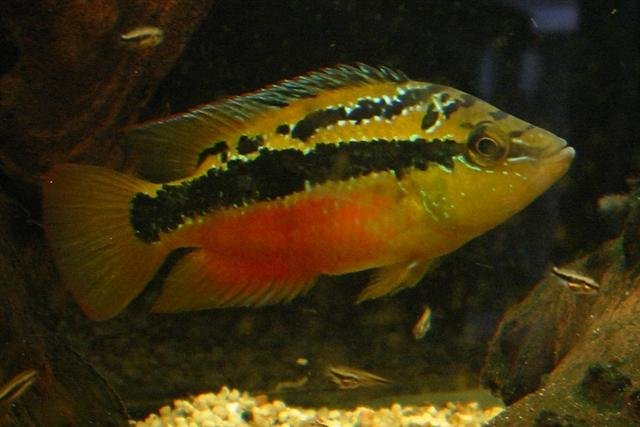
In their tank you should have lots of live aquarium plants, open swimming areas with a strong current, and driftwood and decor to allow your salvini cichlid to establish a territory.
This is an aggressive, territorial fish whom will attack others. However, they are not as aggressive towards other salvini cichlids, so it is possible to keep one male and female together.
18. Celestial Pearl Danio (Danio margaritatus)

- Common Names: Celestial Pearl Danio, Galaxy Rasbora
- Scientific Name: Danio margaritatus
- Family: Cyprinidae
- Lifespan: 3-5 years
- Size: 1 inch (2.5 cm)
- Tank size: 10 gallon (38 liter)
- Temperature: 73°-79°F (22.8°-26.1°C)
- pH: 6.5-7.5
- Hardness: 3-6 dGH (50-100 ppm)
- Compatibility: keep with other peaceful community fish
- Care level: Intermediate
The celestial pearl danio is a small torpedo shaped fish with a dark green body covered in bright yellow dots with a reddish-orange belly.
A fascinating and cool fish to watch, often hovering stationary in strange positions for some time before darting in and out of the plants.
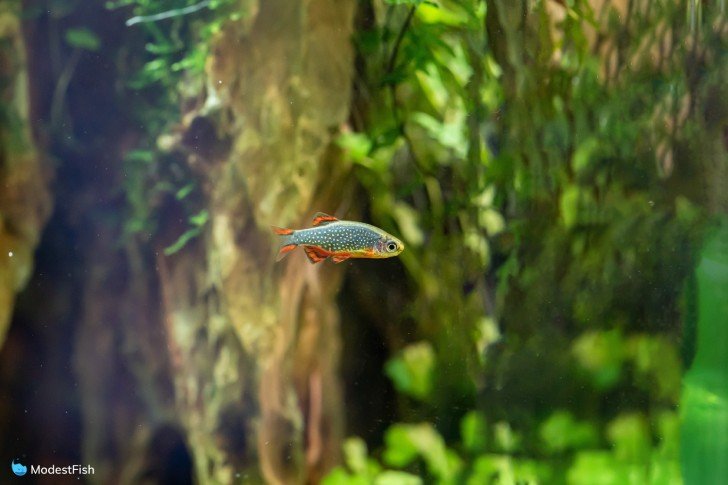
These are hardy-fish who prefer to be in groups (although not a true schooling fish). These colorful freshwater fish are excellent in a community tank. Just be sure to have no bully fish and include lots of live aquarium plants in the tank.
19. Fancy Guppy (Poecilia reticulata)
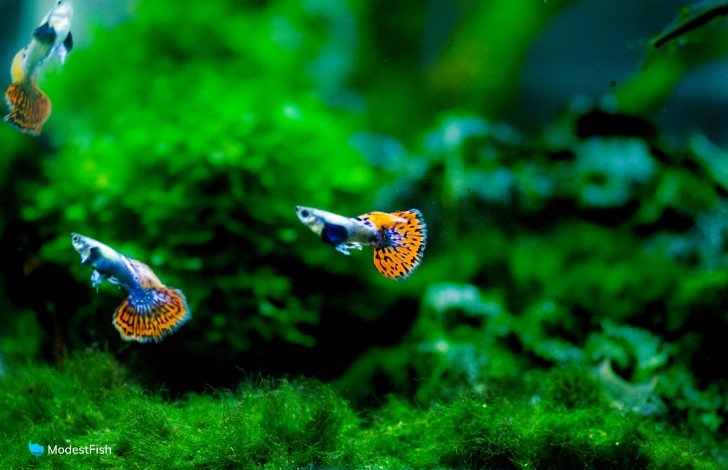
- Common names: Fancy guppies, guppy, millionfish, rainbow fish
- Scientific Name: Poecilia Reticulata
- Family: Poeciliidae
- Lifespan: 2 years
- Size: 2 inches (5 cm)
- Tank size: 5 gallon (19 liters)
- Temperature: 74°-82°F (23.3°-27.8°C)
- pH: 7-7.8
- Hardness: 8-12 dGH (133.4-200 ppm)
- Compatibility: keep with peaceful community fish
- Care level: Beginner
Fancy guppies are some of the most colorful freshwater fish available due to them being so easy to breed. And is one of the most popular and diverse species in the aquarium trade.
There are so many color morphs, patterns, and tail types available it’s impossible for me to even know all of them to explain it. There is no agreed number.
A large group of guppies in a community tank really makes for an eye-catching wash of color. Extremely active, they’ll shoal together near the upper level of your tank.

If you want to keep guppies, you should either have all males or more females than males (1:3 ratio) to control breeding.
20. Florida Flag Fish (Jordanella floridae)
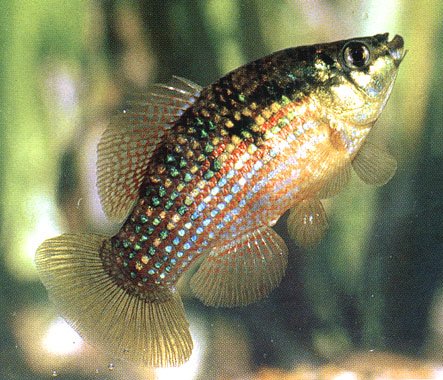
- Common Names: Florida flag fish, American flagfish, Flagfish
- Scientific Name: Jordanella floridae
- Family: Cyprinodontidae
- Lifespan: 2-3 years
- Size: 2 inches (5 cm)
- Tank size: 20 gallons (75 liters)
- Temperature: 70°-85°F (21.1°-29.4°C)
- pH: 6.5-7.5
- Hardness: 12-25 dGH (200-417 ppm)
- Compatibility: fast moving community fish like danios
- Care level: Intermediate
Florida flag fish are small hardy fish who get their name from the males body pattern, which resembles the stars and stripes of the USA. They’re an interesting fish to look at, with their dark blue heads, bulldog-like snout and vibrant body covered in bright green, red, blue and gold iridescent spots.
And they’re not just stunning looking display fish. Florida flag fish are excellent algae eaters (one of the few that will actually eat hair/thread algae), and will help manage the balance of a community tank.
They will spend most of their time at the tip of the water column, florida flag fish are not afraid to jump, so you’ll have to have some kind of aquarium lid.
Mostly peaceful, males can become aggressive during spawning, so you’ll need to provide plenty of space and plants for adults.
21. Rainbow Kribensis (Pelvicachromis pulcher)
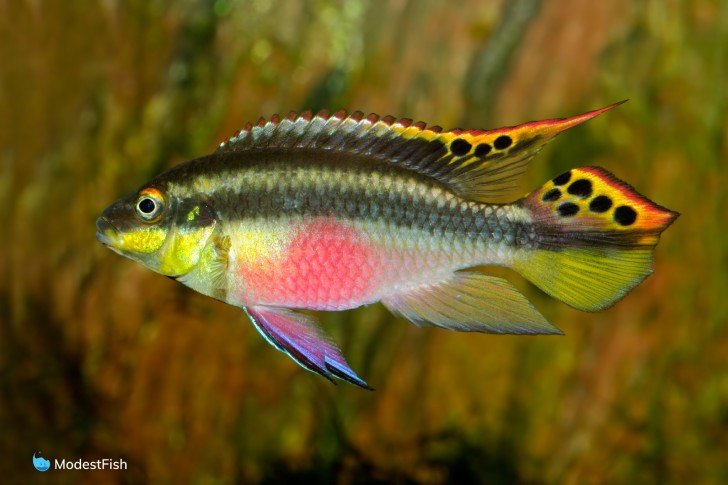
- Common Names: Rainbow Kribensis, Krib, Common krib, Red krib, Super-red krib, rainbow cichlid, purple cichlid
- Scientific Name: Pelvicachromis pulcher
- Family: Cichlidae
- Lifespan: 5 years
- Size: 3-4 inches (7.6-10 cm)
- Tank size: 20 gallon (75 liters)
- Temperature: 75°-80°F (23.9°-26.7°C)
- pH: 6-7
- Hardness: 3-5 dGH (50-83.4 ppm)
- Compatibility: fast-moving peaceful community fish. Avoid other bottom and cave dwellers.
- Care level: Beginner
Named after its beautiful belly (translation from latin name), the rainbow kribensis is famous for its bold coloring.
Both males and females have cherry-red abdomens, which changes intensity during breeding, dark stripes over the head, dorsal area, and lateral line. Some kribensis also have gold-ringed eye spots on their dorsal and caudal fins.
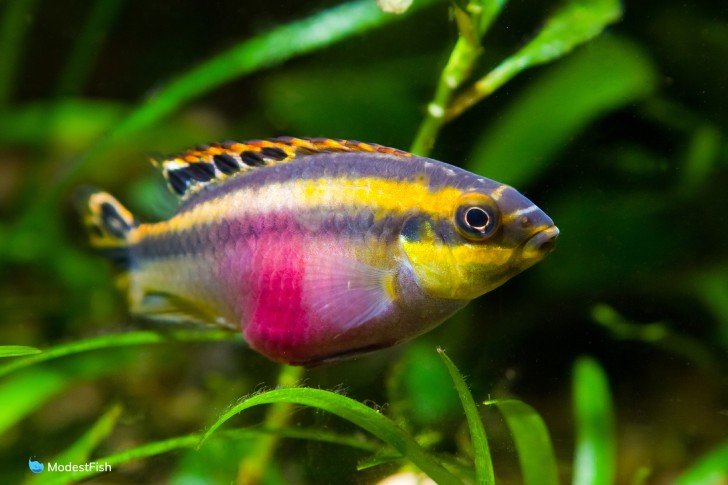
Kribs are a peaceful dwarf cichlid and can be kept in community/species-only tanks. They’ll do well with other peaceful dwarf cichlids, tetra, small barbs etc. They live lots of cover, so caves and plants are a must.
22. Redhead Cichlid (Vieja melanura)
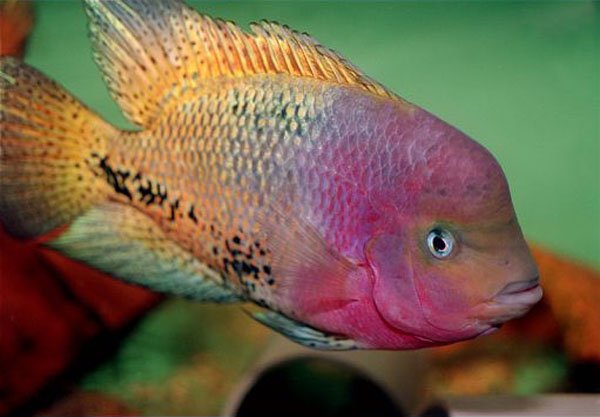
- Common Names: Redhead cichlid, Firehead cichlid, Quetzal cichlid
- Scientific Name: Vieja melanura
- Family: Cichlidae
- Lifespan: 10 years
- Size: 14-16 inches (35.5-40.6 cm)
- Tank size: 55 gallons (210 liters)
- Temperature: 75°-82°F (23.9°-27.8°C)
- pH: 6.5-8.5
- Hardness: 10-15 dGH (166.7-250 ppm)
- Compatibility: other large, calm fish
- Care level: Expert
The male redhead cichlid is one of the most colorful freshwater fish available. Grown males have a thick oval-shaped body, commonly displaying metallic greens, blues, pinks, and oranges. And their short head and nuchal lump is often an intense pinkish red color.
These are large fish, cool looking fish, growing up to 16 inches in length. You’d need at least a 55 gallon long tank with a large footprint for a single fish. Including lots of roots, driftwood, rocks, and open swimming areas.
The redhead cichlid is a mildly-aggressive fish, and although it is possible to keep in an African cichlid community tank, there is no guarantee of success. I would recommend keeping one male or one male and female.
23. Peacock Cichlid (Aulonocara sp.)
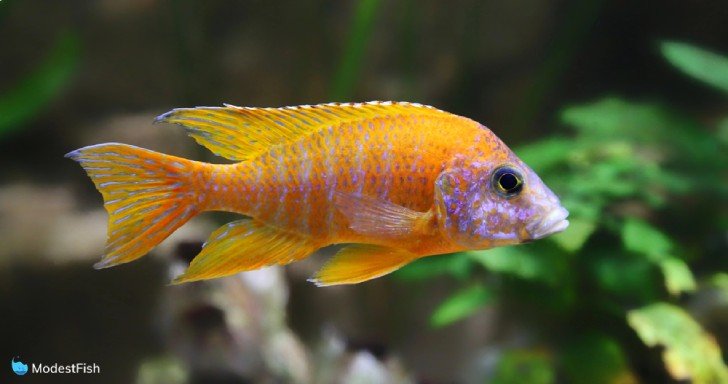
- Common Names: Peacock cichlid
- Scientific Name: Aulonocara sp.
- Family: Cichlidae
- Lifespan: 8 years
- Size: 4-6 inches (10-15 cm)
- Tank size: 55 gallon (210 liters)
- Temperature: 76°-82°F (24.4°-27.8°C)
- pH: 7.8-8.5
- Hardness: 18-25 dGH (300-417 ppm)
- Compatibility: keep with other semi-aggressive African cichlids
- Care level: Intermediate
The peacock cichlid is a stunning, long-bodied fish with large dorsal and anal fins. Males have been selectively bred to have a variety of vivid color combinations.
Some of the most popular varieties include, red peacock cichlid, OB peacock cichlid, blue peacock cichlid, strawberry peacock cichlid and dragon blood peacock cichlid.
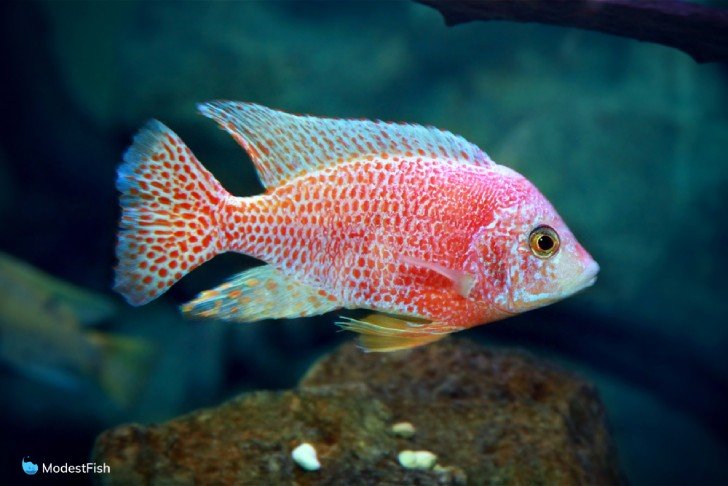
Peacock cichlids can grow up to 6 inches in length and males can be considered semi-aggressive when females are present. Therefore, if you want a group of them, you should keep a male to female ratio of 1:4.
Peacock cichlids are very active and require caves, rocks, driftwood, and plants so they’re able to mark territory.
24. Jewel Cichlid (Hemichromis bimaculatus)

- Common Names: Jewel cichlid, African jewelfish
- Scientific Name: Hemichromis bimaculatus
- Family: Cichlidae
- Lifespan: 5 years
- Size: 5.5-6 inches (14-15 cm)
- Tank size: 30 gallon (114 liters)
- Temperature: 70°F – 74°F (21.1°-23.3°C)
- pH: 7-7.5
- Hardness: 7-18 dGH (116.7-300 ppm)
- Compatibility: should be kept in a species only tank
- Care level: Intermediate
Jewel cichlids are brightly colored, unique looking fish originating from west Africa and often referred to as African Jewelfish.
Available in a number of color combinations, the red jewel cichlid is often the most common found in the aquarium trade. This fish displays a bright red body (which can become more intense with proper care and during breeding), two large black spots, and is covered in iridescent speckles.
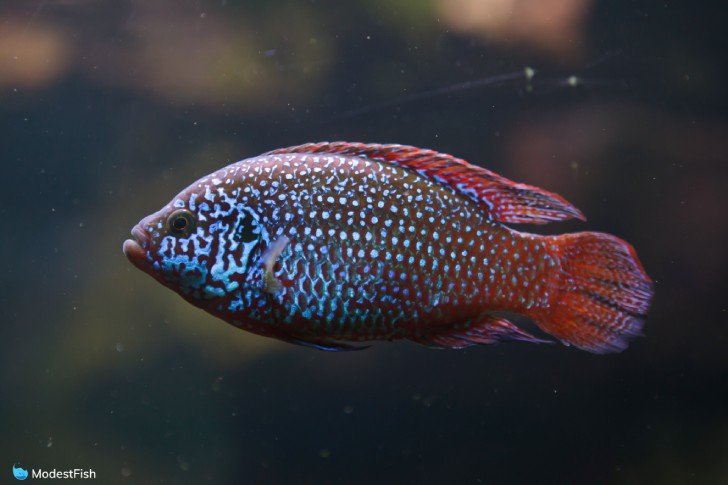
These are very aggressive fish, known for killing much larger fish. I would recommend keeping a single male or female. They grow up to 6 inches and need a minimum 30 gallon long tank with rocks and driftwood.
25. Green Terror Cichlid (Andinoacara rivulatus)
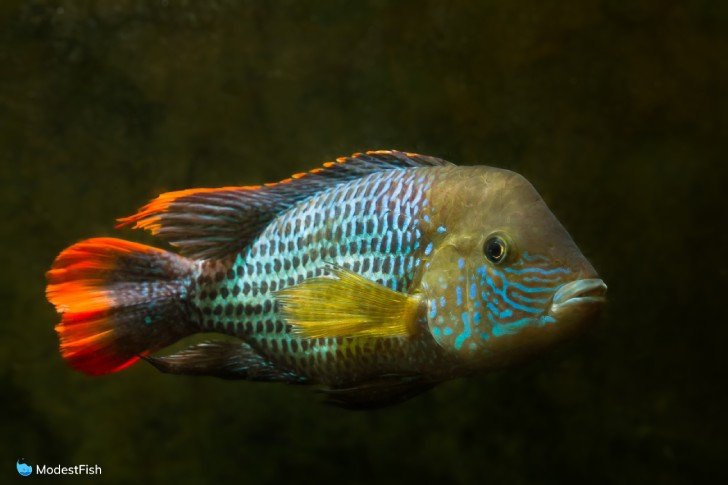
- Common Names: Green Terror Cichlid
- Scientific Name: Andinoacara rivulatus
- Family: Cichlidae
- Lifespan: 7-10 years
- Size: 6-12 inches (15-30 cm)
- Tank size: 55 gallon (210 liters)
- Temperature: 76°-80°F (24.4°-26.7°C)
- pH: 6-7.5
- Hardness: 3-6 dGH (50-100 ppm)
- Compatibility: keep with other large South American cichlids or alone
- Care level: Intermediate
One of, if not the most beautifully colored freshwater aquarium fish, the green terror cichlid and ideal if you’re looking for an awesome display fish.
Green terror cichlids have large olive green heads, and their bodies are rimmed with bright blue/green iridescent color, forming stripes. Males grow a large nuchal hump and will have bright orange stripes on the edges of their dorsal and tail fins.
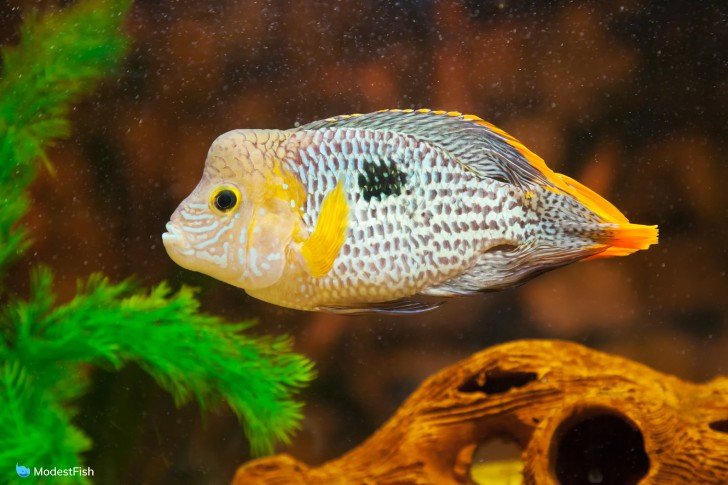
Growing up to a massive 12 inches, green terrors can be very aggressive and should be kept alone, a 1:1 male female ratio or with other similar sized and tempered fish (jack dempseys, fire mouths, flowerhorns).
You would want a 55 gallon tank for a single or 75 for a pair. You should decorate the tank with lots of rocks and driftwood so they have places to mark their territory boundaries. Green terriers are famous for destroying most live plants, so if I were you I wouldn’t include any.
26. Duboisi Cichlid (Tropheus duboisi)
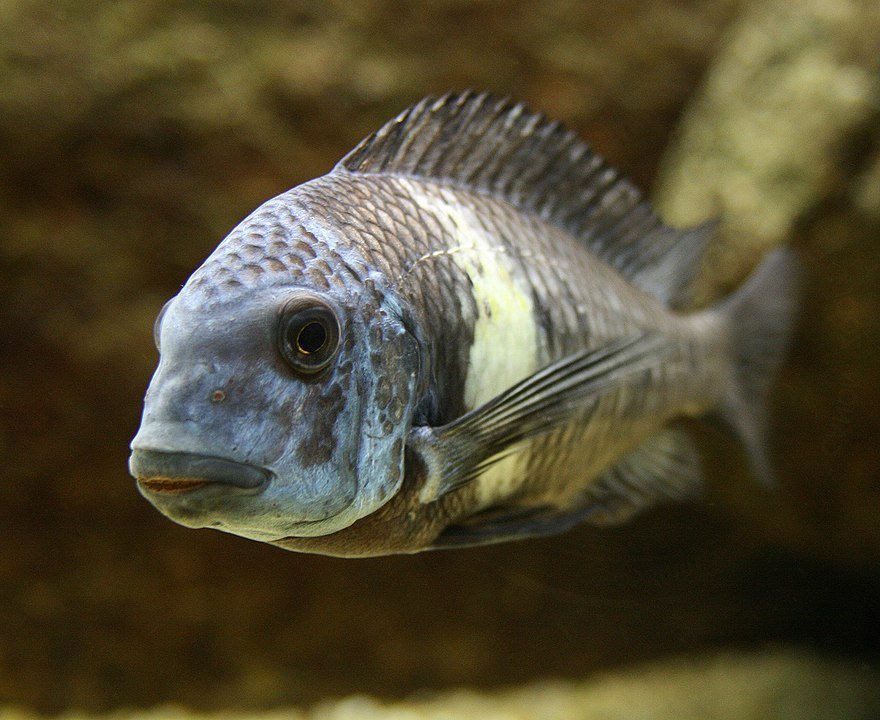
- Common Names: Duboisi Cichlid, blue-faced duboisi
- Scientific Name: Tropheus duboisi
- Family: Cichlidae
- Lifespan: 5 years
- Size: 5 inches
- Tank size: 55 gallon
- Temperature: 72-82° F
- pH: 7.8-9.0
- Hardness: 10-20 dGH
- Compatibility: Aggressive, but can be housed with smaller semi-aggressive Tanganyikan or Malawi cichlids.
- Care level: Expert
Duboisi Cichlids are a cool, unique species of freshwater fish, with their stocky body, large heads, and fan-shaped caudal fin.
A juvenile duboisi has deep black bodies covered in vertical rows of bluish/white dots. As they age, their coloration morphs.
A fully grown Duboisi’s spots will fade, its head will turn a deep blue and develop a bright contrasting yellow band near their pectoral fins.
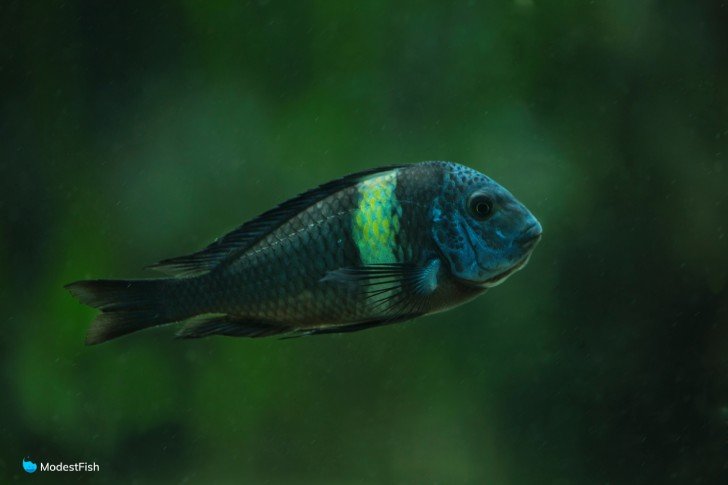
This gorgeous fish can be very aggressive, requires expert care, and should be housed in a species only tank with a minimum of 6. It is possible to house Duboisi cichlids with other smaller semi-aggressive Tanganyikan or Malawi cichlids. But, I wouldn’t recommend this to a beginner.
You would need at least a 55 gallon tank, sand substrate, and lots of aquarium rocks, caves, and African driftwood.
27. Pearl Gourami (Trichopodus leerii)
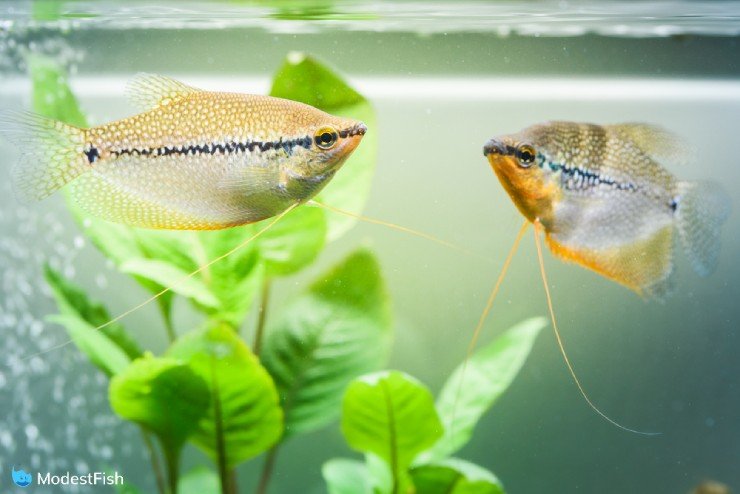
- Common Names: Pearl gourami,
- Scientific Name: Trichopodus leerii
- Family: Osphronemidae
- Lifespan: 4-5 years
- Size: 4-5 inches
- Tank size: 30 gallon
- Temperature: 75-86° F
- pH: 6.5-8.0
- Hardness: 5-18 dGH
- Compatibility: Peaceful community fish
- Care level: Beginner
Pearl gouramis are beautiful fish defined by their shiny mosaic pattern.
Their bodies, often a metallic browny-orange color, are covered in a pearl-like pattern with a strong black line running from its head to the caudal fin. The males often have a bright orange throat, which becomes brighter and more intense during breeding.
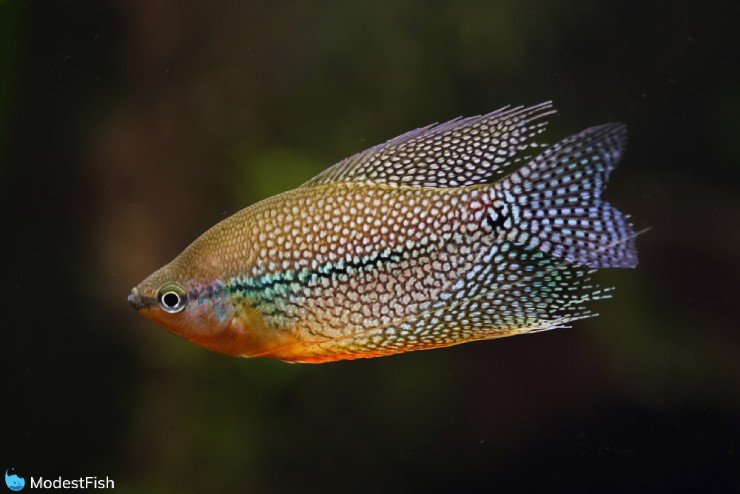
What sets the pearl gourami apart and makes it a cool freshwater fish, is the large wide fins and very long pair of modified ventral fins (which can grow up to 4inches).
Their fancy find makes the prime targets for fin nipper, so keep them in a peaceful community tank. You need at least a 30 gallon tank with lots of plants (especially floating) and dark substrate.
28. Red Shoulder Dwarf Cichild (Apistogramma Macmasteri)

- Common Names: Red Shoulder Dwarf Cichild
- Scientific Name: Apistogramma Macmasteri
- Family: Cichlidae
- Lifespan: 5 years
- Size: two inches
- Tank size: 30 gallons
- Temperature: 72° – 86° F
- pH: 6-7.0
- Hardness: 2015dGH
- Compatibility: Sem-aggressive (mostly during spawning)
- Care level: Beginner
The red shoulder dwarf cichlid is famous for its distinctive bright red and blue facial colors. Both males and females can display vivid coloration, but males are typically more colorful.
When fully grown, adult males will have long flowy fins and a squared-off tail. And it’s dosal fins run the length of its body displaying prominent spikes.
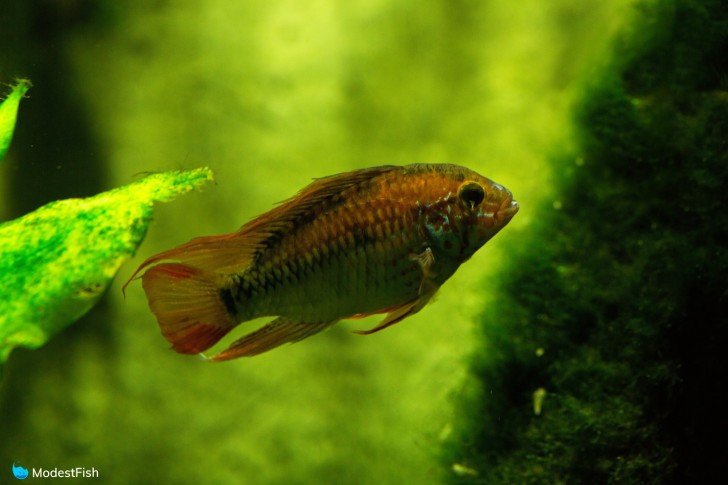
This species of colorful fish will thrive in an environment with sandy substrate, caves, driftwood, rocks, and plenty of open swimming space. While they are small, you can get away with a pair in a 15 gallon tank. However, your fish would be much happier in a group of at least 6 in a 30 gallon aquarium.
29. Jaguar Cichlid (Parachromis managuensis)

- Common Names: Jaguar Cichlid, Managuense cichlid, Aztec cichlid, Spotted guapote
- Scientific Name: Parachromis managuensis
- Family: Cichlidae
- Lifespan: 15 years
- Size: 14 inches
- Tank size: 100 gallon
- Temperature: 75°-82°F
- pH: 7.0-8.7
- Hardness: 10-15 dGH
- Compatibility: Highly aggressive
- Care level: Expert
The jaguar cichlid may not be quite as colorful as some of the other exotic freshwater fish on this list, but it is definitely one of the coolest looking.
Its large, elongated body with an ovate shape is home to varying sizes of black and brown spots on top of a golden yellow body. Just like a jaguar.
The jaguar cichild has prominent, showy dorsal and anal fins supported by spuny rays. And their large mouth and protruding lower jaw with visible teeth make this wild looking fish one of the coolest on this list.
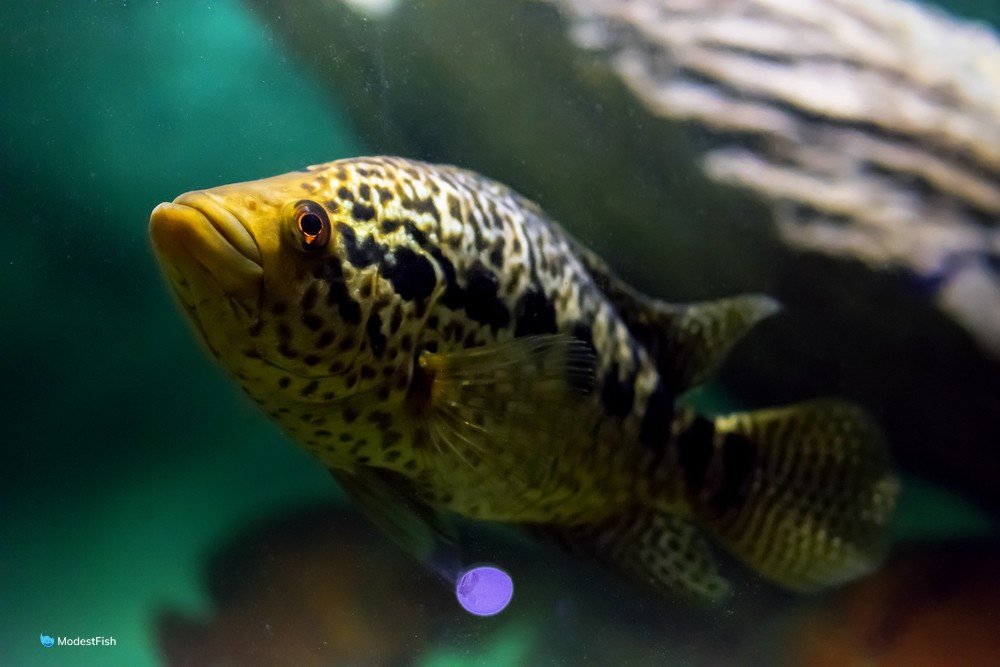
This species of cichlid is massive. Growing up to 14inches long, you’ll need a minimum of 100 gallons for a single male and 150 for a pair. You can house them with other similarly sized and aggressive cichlids. But you will need to provide tons of space for them to set their territories.
30. Congo Tetra (Phenacogrammus interruptus)
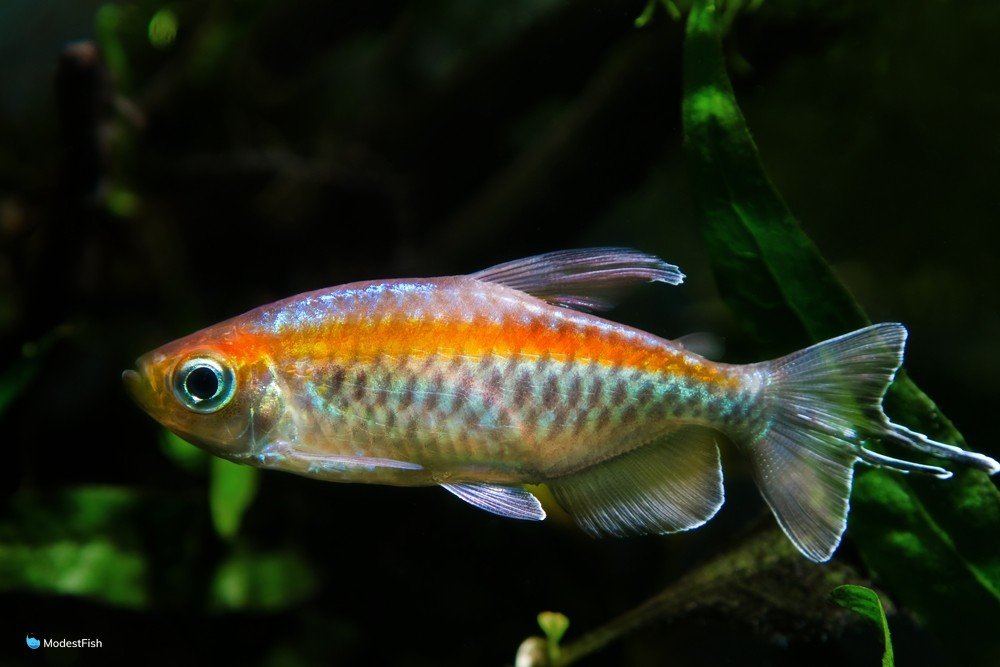
- Common Names: Congo tetra
- Scientific Name: Phenacogrammus interruptus
- Family: Alestidae
- Lifespan:
- Size: 3 inches
- Tank size: 30 gallons
- Temperature: 72-82°F
- pH: 60-7.5
- Hardness: 3-18 dGH
- Compatibility: Peaceful
- Care level: Beginner
Congo tetras, when mature, are full-bodied with large scales and iridescent rainbow coloring which flickers and shimmers under aquarium lights..
What makes congo tetras extra beautiful is their distinctive red and golden line running from their head to their tail fin really stands out against their violet/turquoise body. When fully grown, a congo tetra will develop a gray/violet feathery appendage with white edges on its fins
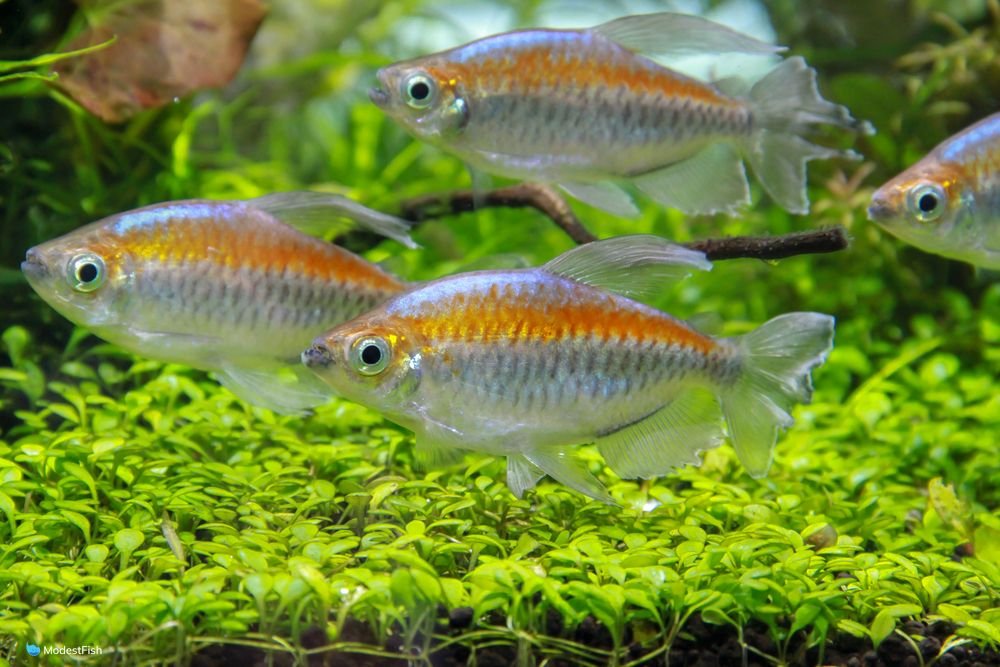
Congos are a peaceful schooling fish, who are best kept in groups of at least 6 in a planted 30 gallon tank.
Which Colorful Fish Do You Think Is Coolest?
By now, you should have plenty of inspiration for your colorful freshwater fish urge.
Your next step is to research the ones you like the most, and make sure you’re able to provide optimal care to get the most enjoyment out of these beauties.
I hope I’ve given you some ideas to run with. And if you have anymore suggestions, let me know in the comments.

Thanks for the article.
Really enjoyed reading through and getting educated on the choice of fish for my daughter
Thanks once again
I think that neon tetra is the coolest
Thanks it helped me with my Science project.
Wow nice fish thanks